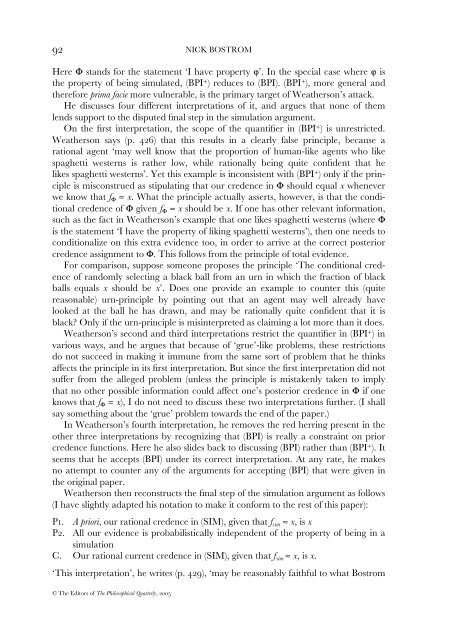Reply to Weatherson - The Simulation Argument
Reply to Weatherson - The Simulation Argument
Reply to Weatherson - The Simulation Argument
Create successful ePaper yourself
Turn your PDF publications into a flip-book with our unique Google optimized e-Paper software.
92 NICK BOSTROMHere Φ stands for the statement ‘I have property ϕ’. In the special case where ϕ isthe property of being simulated, (BPI + ) reduces <strong>to</strong> (BPI). (BPI + ), more general andtherefore prima facie more vulnerable, is the primary target of <strong>Weatherson</strong>’s attack.He discusses four different interpretations of it, and argues that none of themlends support <strong>to</strong> the disputed final step in the simulation argument.On the first interpretation, the scope of the quantifier in (BPI + ) is unrestricted.<strong>Weatherson</strong> says (p. 426) that this results in a clearly false principle, because arational agent ‘may well know that the proportion of human-like agents who likespaghetti westerns is rather low, while rationally being quite confident that helikes spaghetti westerns’. Yet this example is inconsistent with (BPI + ) only if the principleis misconstrued as stipulating that our credence in Φ should equal x wheneverwe know that f Φ = x. What the principle actually asserts, however, is that the conditionalcredence of Φ given f Φ = x should be x. If one has other relevant information,such as the fact in <strong>Weatherson</strong>’s example that one likes spaghetti westerns (where Φis the statement ‘I have the property of liking spaghetti westerns’), then one needs <strong>to</strong>conditionalize on this extra evidence <strong>to</strong>o, in order <strong>to</strong> arrive at the correct posteriorcredence assignment <strong>to</strong> Φ. This follows from the principle of <strong>to</strong>tal evidence.For comparison, suppose someone proposes the principle ‘<strong>The</strong> conditional credenceof randomly selecting a black ball from an urn in which the fraction of blackballs equals x should be x’. Does one provide an example <strong>to</strong> counter this (quitereasonable) urn-principle by pointing out that an agent may well already havelooked at the ball he has drawn, and may be rationally quite confident that it isblack? Only if the urn-principle is misinterpreted as claiming a lot more than it does.<strong>Weatherson</strong>’s second and third interpretations restrict the quantifier in (BPI + ) invarious ways, and he argues that because of ‘grue’-like problems, these restrictionsdo not succeed in making it immune from the same sort of problem that he thinksaffects the principle in its first interpretation. But since the first interpretation did notsuffer from the alleged problem (unless the principle is mistakenly taken <strong>to</strong> implythat no other possible information could affect one’s posterior credence in Φ if oneknows that f Φ = x), I do not need <strong>to</strong> discuss these two interpretations further. (I shallsay something about the ‘grue’ problem <strong>to</strong>wards the end of the paper.)In <strong>Weatherson</strong>’s fourth interpretation, he removes the red herring present in theother three interpretations by recognizing that (BPI) is really a constraint on priorcredence functions. Here he also slides back <strong>to</strong> discussing (BPI) rather than (BPI + ). Itseems that he accepts (BPI) under its correct interpretation. At any rate, he makesno attempt <strong>to</strong> counter any of the arguments for accepting (BPI) that were given inthe original paper.<strong>Weatherson</strong> then reconstructs the final step of the simulation argument as follows(I have slightly adapted his notation <strong>to</strong> make it conform <strong>to</strong> the rest of this paper):P1. A priori, our rational credence in (SIM), given that f sim ≈ x, is xP2. All our evidence is probabilistically independent of the property of being in asimulationC. Our rational current credence in (SIM), given that f sim ≈ x, is x.‘This interpretation’, he writes (p. 429), ‘may be reasonably faithful <strong>to</strong> what Bostrom© <strong>The</strong> Edi<strong>to</strong>rs of <strong>The</strong> Philosophical Quarterly, 2005


